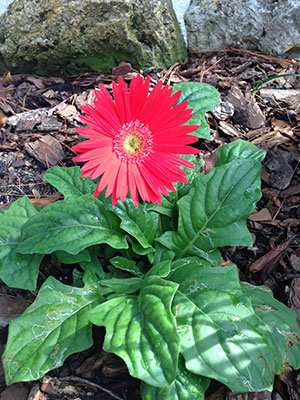Gerbera Daisy

While in much of the country Gerbera daisies are only grown as seasonal annuals, Florida gardeners are lucky enough to grow and enjoy these bright flowers nearly year-round. Related to sunflowers and marigolds, Gerbera daisies have long lasting 3-4 inch flower that come in numerous forms and bright shades of yellow, white, pink, lavender, red, and orange.
Characteristics
Gerbera daisies (Gerbera jamesonii) are native to South Africa. Each Gerbera flower sits on a long leafless stem about 6 inches above the plant’s foliage. These plants form dense, 12-inch tall clumps of long, slightly “fuzzy” leaves. Not only will Gerberas produce flowers for a good period of time in the garden, their blooms make long-lasting cut flowers that can be used to decorate your home.
Gerbera daisies do well in containers and as perennial bedding plants in Central and South Florida. In areas where prolonged freezes are likely they should be treated as annuals or over-wintered indoors.
Planting and Care
Gerberas prefer an area of the garden where they will receive morning sunshine and afternoon shade. For best results, plant your Gerbera daisies in sandy soils that have been amended with organic matter. You can add an inch or two of peat, compost, or another organic material to your soil as an amendment before planting them.
Good drainage is another important soil characteristic for growing Gerberas; excessive moisture can lead to root and crown disease in your plants. If your soil does not have good drainage, consider growing your Gerberas in raised beds, mounds, or containers.
Gerberas are available as potted plants or as pass-along divisions from other gardeners. If you are planting Gerberas that have been growing in a pot, water the plants well before removing them from their container. When you remove your plant from the pot, take a good look at the roots; if they appear “pot bound,” carefully loosen the root ball. Gerbera daisies can also be propagated from seed.
Plant Gerberas 12 to 18 inches apart with the crown (the point where the steam and roots meet) at or slightly above the soil level, in areas where they will receive full or part sun. Gerbera daisies like a regular moisture level; however, the crown should be allowed to dry out between waterings. You can help regulate the soil moisture by mulching around your plants—just be sure not to bury the crown.
Fertilize your daisies regularly for best results. You can apply a controlled-release fertilizer two or three times during the growing season, or you can use a complete fertilizer once a month. Gerberas can be deficient in iron and manganese, so look for a fertilizer or foliar spray containing these micronutrients.
Over time, these plants will sink into the soil, and after a year or two the crown can become entirely covered. To prevent crown rot—caused by excess moisture—dig, lift, and replant your Gerberas periodically.
You can divide Gerbera daisies with multiple crowns at any time in South Florida, while gardeners in North and Central Florida can divide Gerberas in the spring and summer. To divide, dig up the plant and separate the crowns using a clean, sharp knife or pruning shears. Remove any dead roots, old decaying leaves, and one half of all the lower mature leaves. Replant your Gerberas immediately. Until they have re-established, keep the transplants moist.
With proper care, Gerbera daisies can provide you with colorful blooms throughout the warmer months. For more information on growing Gerberas and other plants in your area, contact your county Extension office.
